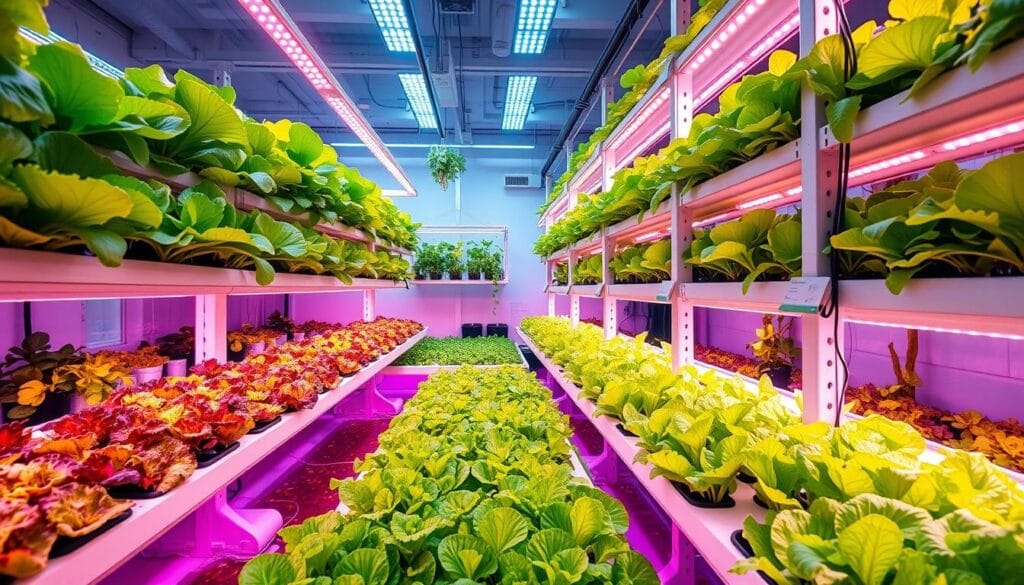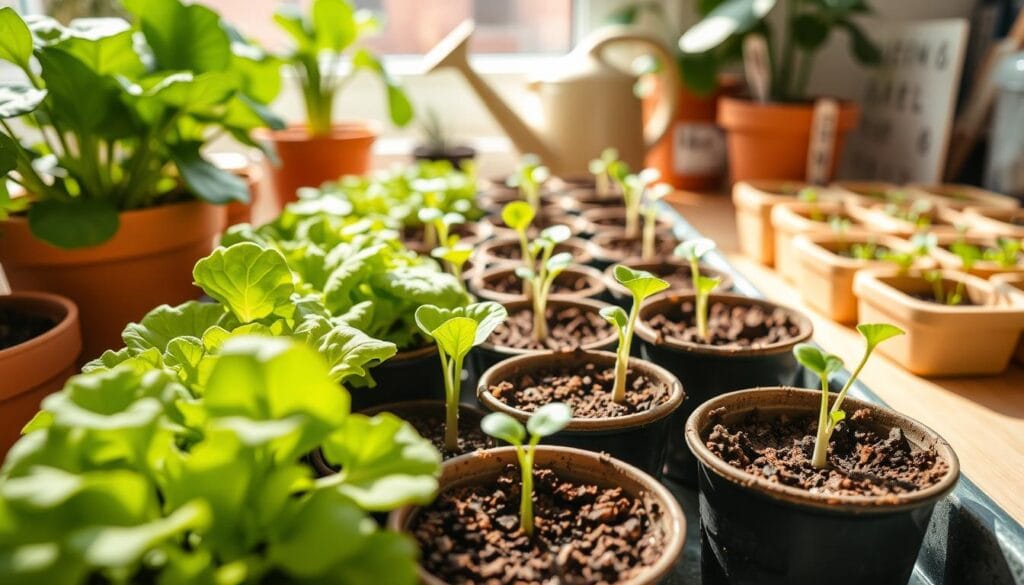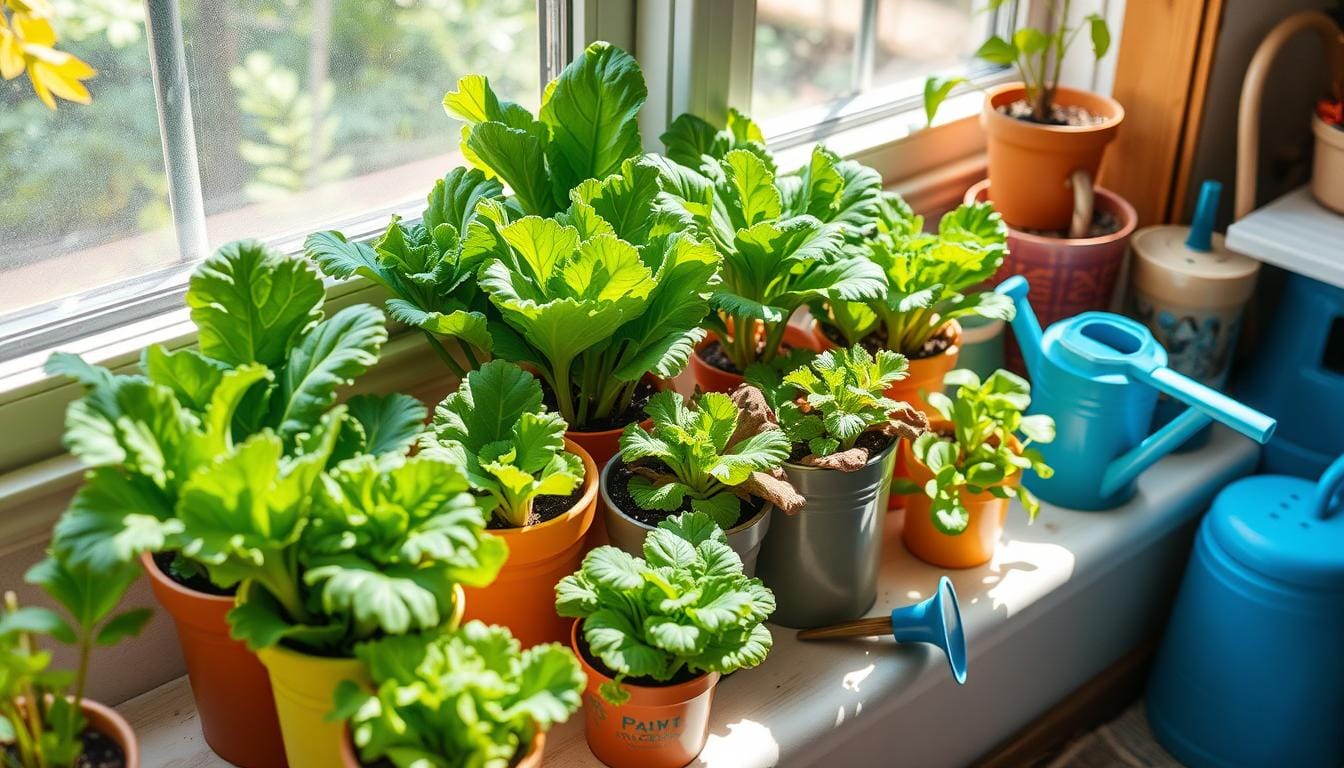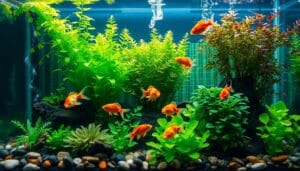Table of Contents
Growing an indoor lettuce garden is a rewarding experience. It changes how you think about food. Many people now grow fresh greens at home, thanks to urban living.
This article will help you create your indoor lettuce garden. You’ll learn about hydroponics, grow lights, and seed starting. It’s all about making your garden a success.
Imagine having fresh, organic lettuce whenever you want. Your own indoor garden means delicious, healthy food and pride in growing it. Let’s dive into the world of indoor gardening and how to make it work in your home!

Understanding Indoor Gardening
Indoor gardening is a great way to grow food in the city. It lets you grow fresh produce like lettuce, no matter the weather outside. This approach makes your food healthier and can even help your mood.
Benefits of Indoor Gardening
There are many good reasons to grow plants indoors:
- Year-round cultivation: You can grow lettuce and other veggies anytime, not just in certain seasons.
- Access to fresh produce: Harvest fresh, organic veggies right from your home.
- Reduced carbon footprint: Growing your own food cuts down on trips to the grocery store, which helps the environment.
- Ideal for limited spaces: Indoor gardening works well in small spaces, like apartments and tiny homes.
Choosing the Right Space for Your Garden
When setting up an indoor lettuce garden, picking the right spot is key. Think about these things:
| Factor | Ideal Conditions |
|---|---|
| Light Availability | Bright indirect light; extra grow lights can help plants grow better. |
| Temperature | Between 60°F and 70°F is best for lettuce to grow well. |
| Humidity | Keep the humidity moderate to keep plants healthy. |
| Accessibility | Make sure your garden is easy to get to for upkeep and picking veggies. |
Essential Supplies for Your Indoor Lettuce Garden
Starting an indoor lettuce garden needs the right supplies. The containers and planters are key for growth. The soil and growing mediums support healthy plants. Knowing these helps create a great space for your lettuce.
Containers and Planters
Choosing the right containers and planters is crucial. Different sizes and materials affect drainage and moisture. Think about these factors:
- Size: Bigger pots help roots grow, while smaller ones fit tight spaces.
- Material: Ceramic pots look nice but need more moisture care. Plastic pots are easy to move.
- Drainage: Make sure pots have holes to avoid waterlogged soil and root rot.
Self-watering pots keep moisture steady, which lettuce loves. They help avoid watering mistakes, keeping plants hydrated.
Soil and Growing Medium Options
Choose a good soil mix for veggies or hydroponic options. Each has its own benefits:
| Soil Type | Description | Advantages | Disadvantages |
|---|---|---|---|
| Potting Soil Mix | A mix of organic matter for plants. | Keeps moisture well and is nutrient-rich. | Can get compact, needing air. |
| Coconut Coir | Fiber from coconut husks. | Great for air and water flow; pH is just right. | May need extra nutrients for growth. |
| Rock Wool | Synthetic for hydroponics. | Supports roots well and drains water. | Can hold too much water if not watched. |
Good aeration and drainage help roots grow well. Watch the pH to match nutrient solutions to your plants. Knowing this helps your indoor lettuce garden thrive.

Choosing the Best Lettuce Varieties
Indoor gardening lets you grow many lettuce types all year. Picking the right lettuce is key for a great indoor garden. Some lettuces taste amazing and are easy to grow. Knowing about these greens helps you grow better indoors.
Popular Varieties for Indoor Growth
Many lettuce types are perfect for indoor gardens. They offer different tastes and textures. Here are some top picks:
- Butterhead Lettuce: It has soft leaves and a sweet taste, perfect for salads.
- Romaine Lettuce: Its crisp leaves and strong flavor are great for Caesar salads.
- Leaf Lettuce: It comes in green and red, grows fast, and tastes mild.
Each lettuce type needs its own special care. This lets gardeners create the best indoor growing space.
Considerations for Leafy Greens
When picking lettuce for indoor gardens, think about how they grow. Important things include:
| Factor | Impact on Growth |
|---|---|
| Light Requirements | All lettuce types need bright, indirect light for 12-16 hours a day. |
| Temperature | The best temperatures are 60°F to 70°F. Too hot can slow growth. |
| Pest Susceptibility | Leafy greens can get pests like aphids. Watch them closely to keep them safe. |
Choosing fast-growing lettuce can help you get more harvests. Also, remember to feed them right to improve their taste. Knowing these tips helps you grow better indoors.

Setting Up Hydroponic Systems
Starting a hydroponic indoor lettuce garden is a cool way to grow plants without soil. There are many hydroponic systems for lettuce, each with its own perks. Knowing how they work helps you set them up and keep them running well.
Types of Hydroponic Systems
There are several hydroponic systems for growing lettuce. Each one works in a different way. It’s important to pick the right one for your goals:
- Deep Water Culture (DWC): Plants float in a nutrient-rich water solution, getting oxygen from air stones.
- Nutrient Film Technique (NFT): A thin water film flows over the roots, giving plants nutrients and oxygen.
- Ebb and Flow Systems: Plants get flooded with nutrient solution, then drained. This lets them take in nutrients and oxygen.
Advantages of Hydroponics for Lettuce
Hydroponics for indoor lettuce gardens has big benefits:
- Plants grow faster: Hydroponics gives plants direct access to nutrients.
- Less space needed: These systems make the most of small spaces.
- Less water used: Hydroponics uses less water than soil gardening.
- Fewer pests and diseases: The controlled environment means healthier plants.

The advantages of hydroponic systems make them great for indoor lettuce gardens. By choosing the right system and understanding its benefits, you’re ready for a thriving garden.
Optimal Lighting Solutions
Lighting is key for a successful indoor lettuce garden. Grow lights mimic sunlight, giving plants the energy they need. Since natural light can be limited indoors, especially in winter, grow lights are essential. They provide the right light spectrum for your lettuce to grow well, keeping it vibrant and crisp.
Importance of Grow Lights
Grow lights offer a steady and adjustable light source for indoor gardens. They solve problems like too little sunlight and changing day lengths. By using grow lights, you can see your lettuce grow faster, yield more, and stay healthier. There are different grow lights for each stage of growth, helping meet your plants’ needs.
Best Types of Grow Lights for Lettuce
Choosing the right grow lights is crucial for your indoor lettuce garden. Here are the top picks, each with its own benefits:
| Type of Grow Light | Pros | Cons |
|---|---|---|
| LED Lights | Energy-efficient, long lifespan, low heat output | Higher initial cost |
| Fluorescent Lights | Cost-effective, readily available, good for seedlings | Shorter lifespan |
| HID Lights | High intensity, great for larger spaces | High heat output, higher energy consumption |
By looking at these grow light options, you can pick the best for your indoor lettuce garden. This will help create a thriving environment for your leafy greens.
Seed Starters and Planting Techniques
Starting an indoor lettuce garden needs careful seed starters and planting techniques. Learning these basics can improve your lettuce plants’ growth and yield. This section will guide you on starting lettuce seeds indoors and transplanting seedlings.
How to Start Lettuce Seeds Indoors
To germinate lettuce seeds indoors, pick high-quality seed starters. They should offer the right conditions for growth. Here’s how to start:
- Choose the Right Containers: Small trays or seedling pots are best.
- Optimal Temperature: Keep temperatures between 65°F and 75°F for germination.
- Sow Seeds: Place seeds about 1/4 inch deep in moist soil.
- Moisture Management: Keep the soil consistently moist but not waterlogged.
- Timing: Start sowing seeds indoors 4-6 weeks before the last frost date.
Transplanting Seedlings Successfully
Transplanting seedlings is key to a thriving indoor lettuce garden. Remember these tips:
- Timing: Wait until seedlings have at least two true leaves before transplanting.
- Preparing the New Containers: Use larger pots with quality potting mix or hydroponic solutions.
- Handle Carefully: Gently squeeze the seedling container to loosen and lift the seedlings carefully, avoiding root damage.
- Placement: Place seedlings at the same depth as in the seed tray.
- Water Immediately: Water the seedlings lightly after transplanting to reduce shock.

Nutrient Solutions for Healthy Growth
A successful indoor lettuce garden needs the right nutrient solutions for growth. Lettuce needs a mix of nutrients like nitrogen, phosphorus, and potassium. It also needs calcium and magnesium. Knowing these needs helps gardeners keep the nutrients balanced for the best growth.
Understanding Nutrient Requirements
Nutrient solutions are key for lettuce plants. Nitrogen makes leaves green, phosphorus helps roots and flowers, and potassium makes plants strong. Calcium builds cell walls, and magnesium is crucial for photosynthesis. Checking nutrient levels often prevents growth problems.
Choosing the Right Nutrient Solutions
Choosing the right nutrient solutions is important for indoor lettuce gardening. You can pick ready-made hydroponic mixes or make your own with organic materials. Hydroponic mixes are easy and consistent. DIY solutions can be made with common organic materials, making them sustainable.

When giving nutrients, protect your plants. Use slow-release fertilizers or liquid feeds to keep nutrients steady. Good management leads to healthy lettuce plants with the right nutrients.
| Nutrient | Function | Sources |
|---|---|---|
| Nitrogen | Promotes growth and leaf development | Urea, ammonium nitrate |
| Phosphorus | Supports root and flower development | Bone meal, rock phosphate |
| Potassium | Enhances overall plant resilience | Potassium sulfate, green compost |
| Calcium | Aids in cell wall structure | Gypsum, lime |
| Magnesium | Essential for photosynthesis | Epsom salt, dolomite lime |
Creating a Space-Saving Indoor Lettuce Garden
Urban living is changing fast, and we need new ways to garden. Vertical farming is a great solution for small spaces. It lets us grow lots of lettuce indoors, even when space is tight.
Vertical Farming Techniques
Vertical gardening grows plants up instead of out. It uses cool products like:
- Wall-mounted planters turn walls into gardens.
- Tiered shelving offers many layers for plants.
- Freestanding gardens can move for better light.
Think about where to put plants for sunlight and water. Grouping plants by their needs keeps them healthy.
Maximizing Limited Space in Urban Environments
Urban areas can be tough for gardening, but we can get creative. Here are some tips:
- Use windowsills for lettuce that loves sunlight.
- Turn furniture into plant stands, like bookshelves.
- Make spaces that do double duty, like gardening and living areas.
Urban gardeners have shown us that even small spaces can grow great lettuce. Their stories inspire us to garden in our own small ways.

| Vertical Farming Technique | Benefits | Ideal for |
|---|---|---|
| Wall-mounted planters | Maximizes vertical space | Small apartments |
| Tiered shelving | Increases accessibility | Balconies and patios |
| Freestanding vertical gardens | Easy to move around | Limited indoor areas |
Using these methods can make growing lettuce indoors fun and space-efficient. With vertical farming and smart design, city folks can enjoy their harvest, no matter how small their space.
Watering and Maintenance Tips
Getting the right watering schedule is key for a healthy indoor lettuce garden. Lettuce needs steady moisture. Knowing how much water it needs is crucial. This helps prevent problems like wilting or root rot.
Using different techniques can make managing your garden easier.
Watering Schedules and Techniques
Choosing the right watering schedule depends on several things. These include the lettuce type, growing medium, and environment. Here are some tips for watering:
- Check the soil moisture often. A simple finger test can tell you when to water.
- Water deeply but not too often. This helps plants grow strong roots.
- Use a drip irrigation system for hydroponic setups. It ensures accurate watering.
- Change your schedule based on humidity and temperature. Hotter, drier conditions might need more water.
Common Problems and Solutions
Gardeners often face challenges with indoor lettuce. Spotting and fixing these problems quickly can save your crop. Here are some common issues and their solutions:
| Common Problem | Possible Cause | Solution |
|---|---|---|
| Wilting Leaves | Insufficient watering | Water right and keep a steady schedule. |
| Yellowing Leaves | Nutrient deficiencies or overwatering | Check nutrients and adjust watering. |
| Pests like aphids | Poor air circulation | Boost airflow and add beneficial insects. |
| Root Rot | Overwatering or poor drainage | Make sure containers drain well and adjust watering. |
Harvesting Your Indoor Lettuce Garden
Harvesting is the exciting end of growing an indoor lettuce garden. Picking your lettuce at the right time makes it taste better and feel fresher. Keep an eye on your plants to know when it’s the best time to harvest.
When to Harvest for Best Flavor
When you pick your lettuce matters a lot for its taste. Young leaves are usually tender and taste great. Try to pick them when they’re about 6 to 8 inches tall, or when the outer leaves look bright and healthy.
Checking your plants often helps you see how they’re growing. This way, you can pick them at the perfect time for the best flavor.
Techniques for Harvesting Lettuce
Using the right way to harvest can help your lettuce garden last longer. Here are a few methods:
- Cut-and-Come-Again: This method lets you pick the outer leaves and still have the inner ones grow. It helps your plant keep growing, so you can have fresh lettuce many times.
- Whole-Head Harvesting: This is good for lettuce that grows into a tight head. You cut the whole plant off at the base. It’s great for when you need a lot of lettuce for a meal.
After you harvest, make sure to take care of the plants left behind. Give them enough water and light to help them grow back. This way, you’ll have plenty of lettuce to enjoy again.
| Harvesting Method | Benefits |
|---|---|
| Cut-and-Come-Again | Encourages multiple harvests, maintains plant health. |
| Whole-Head Harvesting | Ideal for maximum yield at once, great for cooking. |
Indoor Lettuce Garden Sustainability
Creating a sustainable indoor lettuce garden means using organic materials and cutting down on waste. These steps help your plants grow better and are good for the planet.
Benefits of Organic Materials
Using organic materials in your garden makes the soil healthier. It creates a perfect environment for your lettuce to grow. Here are some key benefits:
- Enhanced Soil Structure: Organic materials help with drainage and air, making roots strong.
- Natural Nutrient Supply: Organic fertilizers give nutrients slowly, helping your lettuce grow well.
- Reduced Environmental Impact: Organic materials reduce harmful chemicals and support more life.
Reducing Waste in Your Gardening Practice
It’s important to cut down on waste for a sustainable garden. A few simple steps can make a big difference:
- Recycling Materials: Turn old containers into planters to reuse them.
- Composting Kitchen Scraps: Make compost from kitchen waste to improve your soil.
- Efficient Resource Use: Water plants carefully and use nutrients wisely to avoid waste.
| Strategy | Benefits |
|---|---|
| Using Organic Materials | Improves soil health and promotes sustainable growth. |
| Composting | Reduces waste and provides nutrient-rich soil additives. |
| Recycling Planters | Minimizes waste and conserves resources. |
| Efficient Watering | Conserves water and prevents nutrient leaching. |
By following these steps, you can create a sustainable indoor lettuce garden. It’s good for your plants and the planet. Using organic materials and reducing waste makes gardening rewarding and sustainable.
Conclusion
Starting an indoor lettuce garden brings many benefits. It’s not just about making your home look good. It also helps you grow your own food in a sustainable way. This means you can enjoy fresh, healthy greens right from your kitchen.
Setting up your indoor garden is easy and fun. You learn about the best lettuce types and how to care for them. It’s more than just growing food; it’s a way to live a healthier, greener life.
We think indoor gardening is a great hobby. It’s good for you and the planet. With a little effort, your garden will grow strong and provide you with delicious greens. So, start your garden today and enjoy the fresh, healthy food it will give you!





